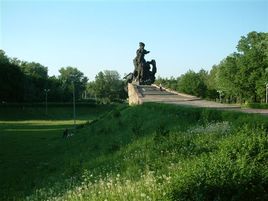 January 27 is Holocaust Memorial Day, a day to remember the six million Jews, and others, killed by the Nazis and their collaborators in World War II. The Holocaust was a brutal attempt to destroy Eastern European Jewry – to wipe out a race in its entirety. The testimonials of those who survived are so harrowing that they make very difficult reading. The most shocking that I have come across is Chil Rajchman’s Treblinka. Rajchman was a young Polish Jew, who was arrested in October 1942 and sent to the Treblinka death camp, a place where three quarters of a million Jews were murdered. His sister, who was arrested with him, was sent immediately to the gas chambers. Rajchman was set to work in the camp, sorting the clothes of the dead, carrying corpses and pulling out their teeth. He and a few other men managed to escape during a camp uprising. The Nazi invasion of 1941 brought the Holocaust to Ukraine. The mass slaughter at Babi Yar is the most widely known event of the massacre of Jews in Ukraine. In just two days at the end of September 1941, nearly 34,000 Jews were shot at a ravine just outside Kiev. A. Anatoli’s ‘documentary novel’ Babi Yar, which was smuggled out of the Soviet Union in 1969, offers a vivid account of the massacre. Over the course of the Nazi occupation, up to 150,000 people may have been killed at Babi Yar, including prisoners of war, communists, Ukrainian nationalists and Roma. Today Babi Yar is a verdant park easily reached by underground train from the centre of Kiev. The land is undulating, with a couple of steepish slopes, but there is little sign of a ravine. It was peaceful when I visited, in May 2005, with groups of young people sitting on the grass enjoying the late afternoon sunshine. A large, rather ugly post-Soviet statue commemorates those who died (see photo). Further away, towards the woods, is second, much smaller memorial, dedicated to the Jews shot at Babi Yar. In Pavolitch (Pavoloch in Russian), where my family comes from, Jews were herded in trucks or on foot from the neighbouring villages and settlements to the Jewish cemetery just outside the town, where more than 1,300 were shot in 1941. Later, in November 1943, when no Jews remained, dozens of other enemies of the Third Reich were locked into the basement of one of Pavolitch’s synagogues and it was set alight. Today, we remember them.
0 Comments
My grandmother grew up in the small town of Pavolitch (Pavoloch in Russian), about 60 miles southwest of Kiev. Around a third of the population of Pavolitch was Jewish at the beginning of the 20th century. Between 1880 and 1924, hundreds of thousands of Jews abandoned the region, as violent anti-Semitic pogroms swept the area known as the Pale of Settlement, the old Polish lands where Jews were confined to living under the Tsars. The bloodiest pogroms took place in 1881 and 1905, each prompting its own exodus. A majority fled to America, but sizeable numbers settled in Canada, the UK and elsewhere. My grandmother fled to Winnipeg, Canada, in 1924, joining her brother, great uncle and cousins who had already made the journey. By 1929, most of her close family had joined her in the Free World.
Almost all Jews who remained in the territory of the Pale after the Nazi invasion of 1941 were slaughtered, most of them shot at mass graves that they were often forced to dig themselves. Some, with great prescience, escaped to the east, to the Urals or Central Asia, and returned only once the war was over. The end of the Soviet era led to another mass wave of Jewish emigration. Between 1989 and 2006, about 1.6 million Jews and their non-Jewish partners and families emigrated from the former Soviet Union. The majority, or close to a million, settled in Israel, but sizeable minorities went to the US and Germany. Among those starting a new life in Germany were several of my relatives, who left Kiev and Odessa keen to rid themselves of a lifetime of anti-Semitism at home and a new brand of lawlessness that had taken hold when the Soviet power structures were toppled. The war in the east of Ukraine since 2014 has prompted another wave of emigration. The fighting has killed more than 9,000 people in the last two years. Around 2,000 have fled the region’s cities, in particular Donetsk, which has come under heavy shelling from the Ukrainian army since it was taken by pro-Russian separatists in April 2014. The Jewish population of Donetsk has dropped from 10,000 to just a few hundred. Some 7,200 Jews fled Ukraine for Israel in 2015, up from 2,000 in 2013. Many more have moved across the border to Russia, and others are living elsewhere in Ukraine. Not regarded as refugees as they remain in their own country, many of them eke out a meagre existence, sleeping on the floors of friends and family, or being supported by international Jewish aid organisations. Around 200,000 Jews are estimated still to live in Ukraine today. |
Keeping stories aliveThis blog aims to discuss historical events relating to the Jewish communities of Ukraine, and of Eastern Europe more widely. As a storyteller, I hope to keep alive stories of the past and remember those who told or experienced them. Like so many others, I am deeply troubled by the war in Ukraine and for the foreseeable future, most articles published here will focus on the war, with an emphasis on parallels with other tumultuous periods in Ukraine's tragic history. Archives
March 2024
Categories
All
|
 RSS Feed
RSS Feed
